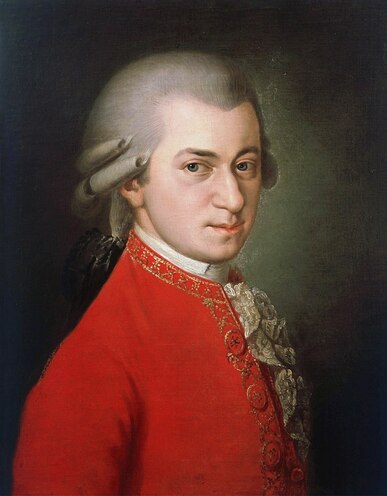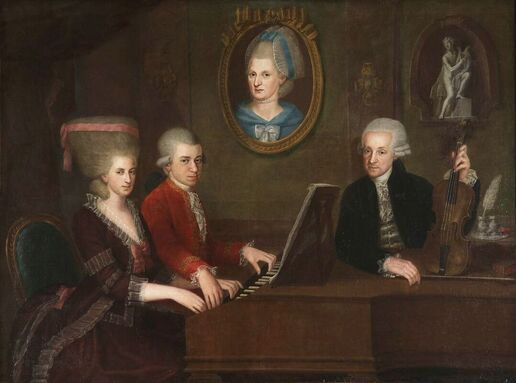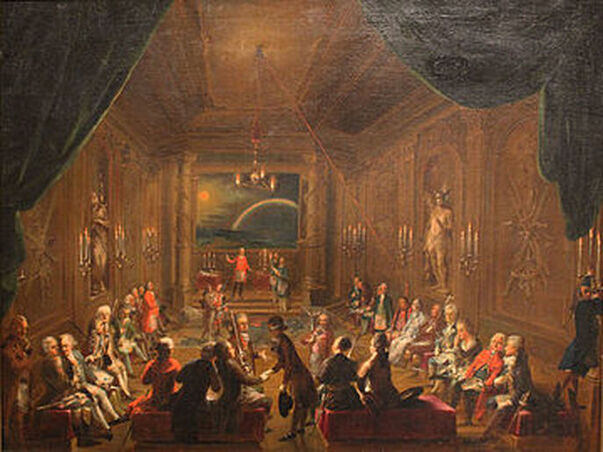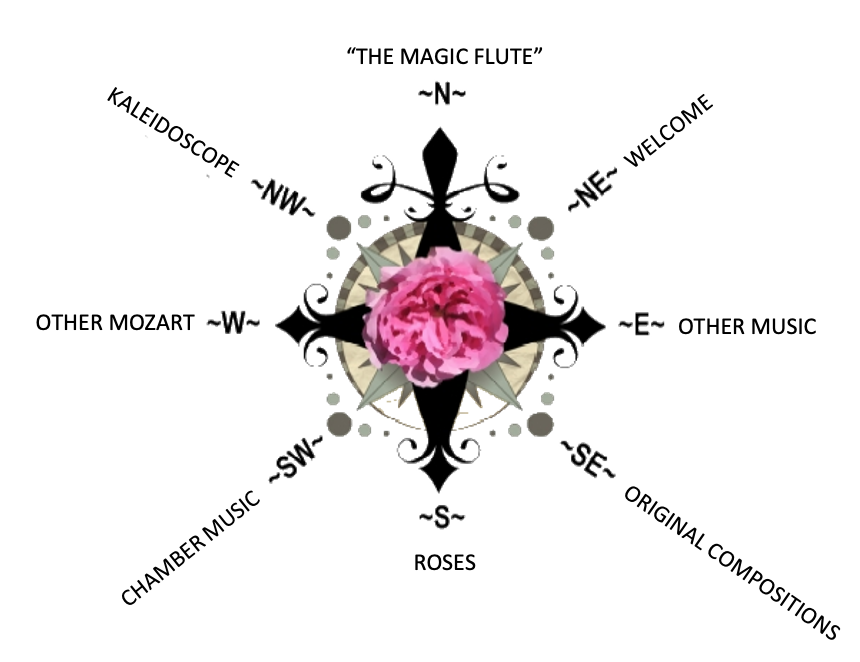- Home
- N - The Magic Flute
- NE - Welcome!
-
E - Other Music
- E - Music Genres >
- E - Composers >
-
E - Extended Discussions
>
- Allegri: Miserere
- Bach: Cantata 4
- Bach: Cantata 8
- Bach: Chaconne in D minor
- Bach: Concerto for Violin and Oboe
- Bach: Motet 6
- Bach: Passion According to St. John
- Bach: Prelude and Fugue in B-minor
- Bartok: String Quartets
- Brahms: A German Requiem
- David: The Desert
- Durufle: Requiem
- Faure: Cantique de Jean Racine
- Faure: Requiem
- Handel: Christmas Portion of Messiah
- Haydn: Farewell Symphony
- Liszt: Évocation à la Chapelle Sistine"
- Poulenc: Gloria
- Poulenc: Quatre Motets
- Villa-Lobos: Bachianas Brazilieras
- Weill
-
E - Grace Woods
>
- Grace Woods: 4-29-24
- Grace Woods: 2-19-24
- Grace Woods: 1-29-24
- Grace Woods: 1-8-24
- Grace Woods: 12-3-23
- Grace Woods: 11-20-23
- Grace Woods: 10-30-23
- Grace Woods: 10-9-23
- Grace Woods: 9-11-23
- Grace Woods: 8-28-23
- Grace Woods: 7-31-23
- Grace Woods: 6-5-23
- Grace Woods: 5-8-23
- Grace Woods: 4-17-23
- Grace Woods: 3-27-23
- Grace Woods: 1-16-23
- Grace Woods: 12-12-22
- Grace Woods: 11-21-2022
- Grace Woods: 10-31-2022
- Grace Woods: 10-2022
- Grace Woods: 8-29-22
- Grace Woods: 8-8-22
- Grace Woods: 9-6 & 9-9-21
- Grace Woods: 5-2022
- Grace Woods: 12-21
- Grace Woods: 6-2021
- Grace Woods: 5-2021
- E - Trinity Cathedral >
- SE - Original Compositions
- S - Roses
-
SW - Chamber Music
- 12/93 The Shostakovich Trio
- 10/93 London Baroque
- 3/93 Australian Chamber Orchestra
- 2/93 Arcadian Academy
- 1/93 Ilya Itin
- 10/92 The Cleveland Octet
- 4/92 Shura Cherkassky
- 3/92 The Castle Trio
- 2/92 Paris Winds
- 11/91 Trio Fontenay
- 2/91 Baird & DeSilva
- 4/90 The American Chamber Players
- 2/90 I Solisti Italiana
- 1/90 The Berlin Octet
- 3/89 Schotten-Collier Duo
- 1/89 The Colorado Quartet
- 10/88 Talich String Quartet
- 9/88 Oberlin Baroque Ensemble
- 5/88 The Images Trio
- 4/88 Gustav Leonhardt
- 2/88 Benedetto Lupo
- 9/87 The Mozartean Players
- 11/86 Philomel
- 4/86 The Berlin Piano Trio
- 2/86 Ivan Moravec
- 4/85 Zuzana Ruzickova
-
W - Other Mozart
- Mozart: 1777-1785
- Mozart: 235th Commemoration
- Mozart: Ave Verum Corpus
- Mozart: Church Sonatas
- Mozart: Clarinet Concerto
- Mozart: Don Giovanni
- Mozart: Exsultate, jubilate
- Mozart: Magnificat from Vesperae de Dominica
- Mozart: Mass in C, K.317 "Coronation"
- Mozart: Masonic Funeral Music,
- Mozart: Requiem
- Mozart: Requiem and Freemasonry
- Mozart: Sampling of Solo and Chamber Works from Youth to Full Maturity
- Mozart: Sinfonia Concertante in E-flat
- Mozart: String Quartet No. 19 in C major
- Mozart: Two Works of Mozart: Mass in C and Sinfonia Concertante
- NW - Kaleidoscope
- Contact
MOZART 1777 - 1785
by Judith Eckelmeyer
(GRACE WOODS MUSIC SESSION SEPTEMBER 6 AND 9, 2021)
Between 1777 and 1785 several major events impacted the life and compositional style of Wolfgang Amadeus Mozart (1756-1791).
The first of these occurred during the lengthy journey of 16 months that he and his mother undertook to Munich; Mannheim, an important music city and the seat of the Elector Palatinate in what is now western Germany; and Paris, all in an intense effort to secure a permanent position in a music-loving court anywhere but in Salzburg. Mozart gained significant valuable new tools for his composing: exciting dynamic possibilities and the relatively recent addition of clarinets to the orchestra’s palette. But while in Paris, his mother contracted a fever which neither the family’s usual remedies nor a physician could cure; she died there in early July, 1778. Although Mozart had been sending numerous letters to his father in Salzburg giving accounts of his journey and the events occurring in the places he visited, he totally avoided revealing his mother’s death. Only upon his return to Salzburg in January 1779 did he tell his father and sister that sorrowful news.
One can only imagine the grief the three Mozarts shared in that year. It appears that Wolfgang’s mourning found an outlet in his composing the Sinfonia Concertante in E-flat (K. 364, 1779). This hybrid concerto/symphony features a solo violin and solo viola with an orchestra including the unusual richness of 2 viola parts. The solo viola part, written in D major, would have required the performer to re-tune (scordatura) his instrument to perform in E-flat, giving it a brighter sound. How remarkable an expression of intimate grief this work reflects might be recognized by the fact that both Wolfgang and his father were skilled performers on the two solo instruments: Leopold, after all, had literally written the book on playing the violin! In my view, the solo viola captures the “voice” of Leopold and the solo viola that of his son Wolfgang. There is, however, no record of the work having been performed in Mozart’s time, although some surmise it was probably performed in Salzburg soon after it was completed. The second movement, in dark C minor, is a quintessential elegy, even to having a funerial procession passage in the course of its unfolding. This passage is highly significant, as it will also appear in a composition of 1785 written for the funeral ritual for two aristocratic Freemasons in Vienna.
Mozart's Sinfonia Concertante for Violin, Viola and Orcedtra
Staatskapelle Berlin Orchestra | Daniel Barenboim, conductor
Wolfram Brandi, violin and Yulia Devneka, Viola
Staatskapelle Berlin Orchestra | Daniel Barenboim, conductor
Wolfram Brandi, violin and Yulia Devneka, Viola
A second impactful event in Mozart’s life was his entrance into Freemasonry, a hugely influential society of which there were by the mid-1780s seven active lodges in Vienna alone. Mozart was raised to the Third Degree early in 1785, and thereafter composed a number of pieces for use in the lodge’s ceremonies, even up to the month before he died; in his enthusiasm for Masonry he encouraged both his father and Franz Joseph Haydn to enter the fraternity. There is also evidence, in my opinion, that even his Requiem, although not completed in his hand at his death, has Masonic aspects.
Mozart composed Maurerische Ttrauermusik (Masonic Funeral Music, K.477) in 1785 on the occasion of the deaths of two fellow Masons, Count Georg August von Mecklenburg-Strelitz, a member of the Lodge “The Three Eagles”, and Count Franz Esterhazy von Galantha, of the Lodge “Crowned Hope”. The work was performed at the Masonic Lodge of Mourning on November 17 of that year. A feature of Masonic ritual, according to Jacques Henri, musicologist and Mason, is ceremonial procession; in the course of the Masonic Funeral Music there is a familiar rhythm strongly reminiscent of the “procession” passage in the second movement of the Sinfonia Concertante.
Another feature of the composition is a passage set as a cantus firmus—a simple melody in longer notes of equal value over an active accompaniment and bass. This tune is a Psalm Tone, structured in two phrases, and commonly used in settings of the Requiem Mass liturgy in the “Te decit hymnus” (“To you a hymn said…”), a part of the Introit. Shortly afterward there is another cantus, not a Psalm tone, but like the Psalm tone it is structured in two phrases. This second cantus is perhaps a melody known by Austrian Masons, but to my knowledge has not been identified.
Finally, at the end of the dark, deeply moving music of this expressive dirge, the last chord astonishes us as a moment of warmth, light, and peace, in keeping with Masonic teaching about the meaning of death as a transition to another life.
Mozart's Maurerische Ttrauermusik, K. 477
Academy of Saint Martin in the Fields | Sir Neville Marriner, conductor
Academy of Saint Martin in the Fields | Sir Neville Marriner, conductor
And third, about the time Mozart moved in 1781 from Salzburg to a more hopeful situation in Vienna, he was introduced in 1782-3 to the music of J. S. Bach, whose work had largely been forgotten as music taste changed radically from Baroque counterpoint to the lighter style of the emerging classical style. Mozart’s compositions from that time onward began to include elements and procedures he was so attracted to in Bach’s music, in particular the fugue and imitative techniques. This addition to the elements that he had garnered from his visit to Mannheim only a few years earlier formed the ground of his fully mature compositions. He had already written a number of string quartets (2 violins, viola and cello), but with his new-found musical language the quartets from 1782 onward achieved a depth of expression and richness of technique. Mozart dedicated six of his quartets of that period (G, D minor, E-flat, B-flat, A, and C) to his friend and mentor, the eminent Franz Joseph Haydn (1832-1909), whose prodigious quartet output of more than 66 such works were an early influence of Mozart. In February of 1785 Haydn was visiting Wolfgang and his father Leopold one evening in Vienna and heard three of these “new quartets”. In response, he declared to Leopold, “Before God and as an honest man I tell you that your son is the greatest composer known to me either in person or by name. He has taste and, what is more, the most profound knowledge of composition.” High praise from the most famous composer of the time!
The beginning of the last of these works, the “Dissonant” in C, K. 465, is the source of its nickname: the slow introduction of the first movement piles note upon note in astonishingly intense relationships that gradually unfold to the sunny Allegro in C. The confusion and darkness of the introduction and its devolvement to “light” have singularly clear Masonic implications, which both Mozarts and Haydn would recognize. The final movement has many Haydn-like features: pauses, unexpected key changes, and a generally playful character.
Judith Eckelmeyer © 2021
Mozart's String Quartet in C, K. 465
Israel Philharmonic
David Radzynski, violin | Dumitru Pocitari, violin | Miriam Hartman, viola | Emanuele Silvestri, cello
Choose Your Direction
The Magic Flute, II,28.






